States with the most anti-LGBTQ+ hate crimes
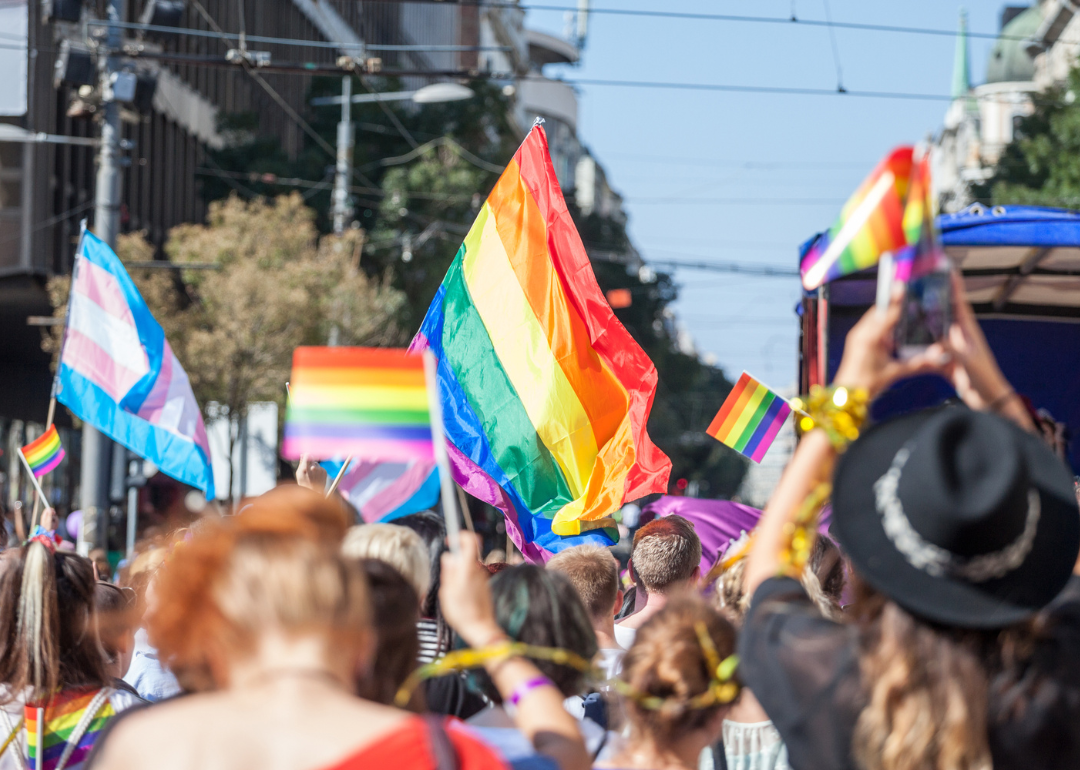
Canva
States with the most anti-LGBTQ+ hate crimes
A crowd raising pride flags during a march.
Hate crime law in the United States is a difficult patchwork to navigate. The legal definition of a hate crime and the groups the law protects still varies by state. Even in its most expansive definition, the nature of the law requires proof of malicious or prejudiced intent, a difficult standard for law enforcement and courts to meet.
In 2009, Congress passed the Matthew Shepard and James Byrd, Jr., Hate Crimes Prevention Act, which expanded the federal hate crime definition and gave the federal government authority to collect statewide data and prosecute hate crimes when local governments do not. As this growing body of data suggests, hate crime is most definitely on the rise. Despite federal reform, many victims and communities remain at the mercy of their state and local government statutes.
The Human Rights Campaign reports that, in 2021, nearly 1 in 5 hate crimes were motivated by anti-LGBTQ+ sentiment, and that year has been the deadliest on record for transgender and nonbinary people. Hate crime exists in a political context: The stark increase in violence in this community is inextricably connected to larger national debates over gender identity and expression. In the year 2021 alone, more than 250 bills the Human Rights Campaign identifies as anti-LGBTQ+ were introduced in state legislatures. The topics most commonly included gender-affirming care for minors, inclusion or exclusion of topics of gender in K-12 schools, and restricting bathroom and locker room use on the basis of biological sex.
LGBTQ+ advocates point out a clear connection between legislation that targets their community and the rates of intimidation and violence they face. According to the Trevor Project, anti-LGBTQ+ policies and debates contributed to a spectrum of harm for LGBTQ+ youth, including online harassment, feelings of unsafety, bullying, and physical assault.
And what other factors form the backdrop of increasing prejudice and violence against LGBTQ+ Americans?
Stacker investigated which states had the most hate crimes against the LGBTQ+ community, using the FBI’s 2021 Hate Crime Statistics. States are ranked by the number of anti-LGBTQ+ hate crimes in 2021. States with an equal number of total hate crimes are ranked by the percentage of police departments that reported data that year. Please note that some crimes involve multiple-bias motivations, so the sum of all hate crimes may equal a different number than the total hate crimes.
Please note: Data collection for these crimes is difficult. The FBI has collected hate crime data since 1991 to provide an overall yearly snapshot, but this picture remains incomplete. Many communities targeted by prejudiced violence do not feel safe around police or trust the police to prosecute their offenders, and survey data from victims report a much higher number of hate crimes than reported by police. Furthermore, police departments are not mandated to report hate crime data to the FBI—and many don’t. Even comparing data year to year can be difficult because each year represents a different sample of police departments that choose to report. It’s safe to assume the hate crime victims face is much higher than reported on FBI statistics.
Read on to understand how legislation, criminal statutes, and other factors impact the violence that LGBTQ+ people face from state to state. Note that the following states were excluded from our list because less than half of police departments in the state reported data: Florida, California, Pennsylvania, Maryland, New York, New Jersey, New Mexico, and Illinois.
![]()
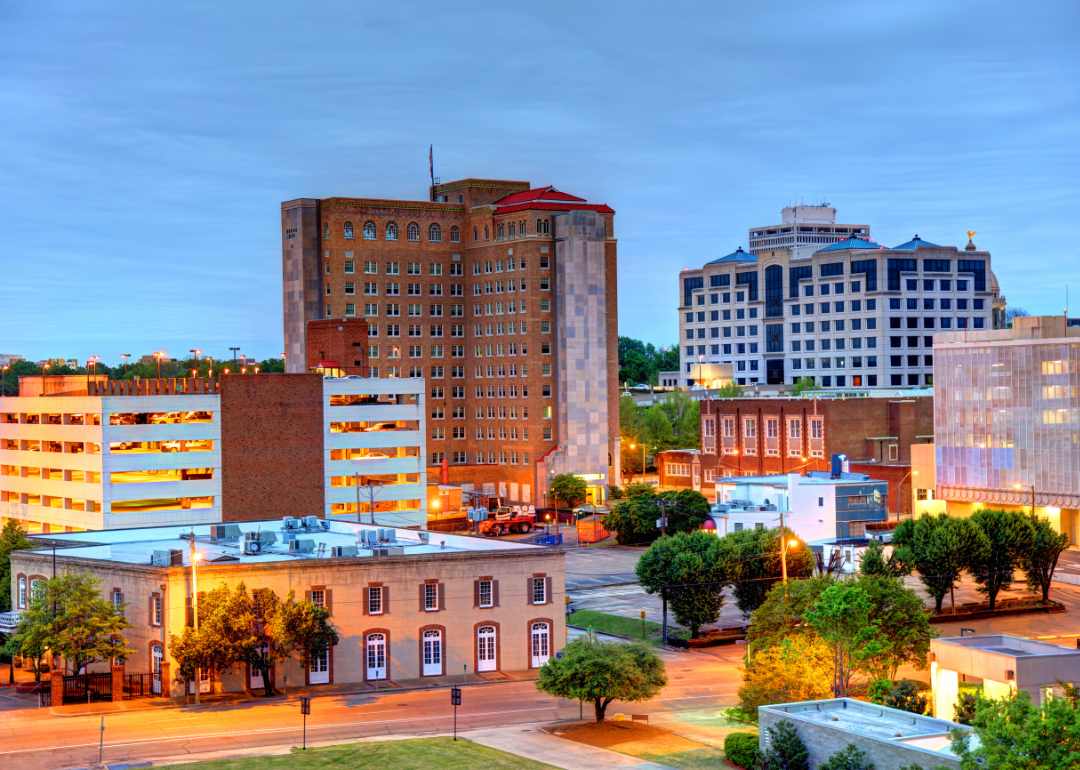
Canva
#43. Mississippi
A parking garage and buildings in downtown Jackson.
– Total reported anti-LGBTQ+ hate crimes, 2021: 1
– Percent of police departments reporting data: 52.9% (138 of 261 departments)
– Number of hate crimes per bias motivation
— Anti-Lesbian: 1
— Anti-Gay: 0
— Anti-Bisexual: 0
— Anti-Gender-Nonconforming: 0
— Anti-Transgender: 0
— Anti-Lesbian, Gay, Bisexual, or Transgender (Mixed Group): 0
Mississippi does not have a hate crime law that includes gender identity or sexual orientation as a factor. LGBTQ+ advocates have long been pushing to expand the legal definition of hate crime to account for crimes against these groups, but the bill has yet to pass. The most current reform of Mississippi hate crime law was in 2017 when a provision was added to protect law enforcement officers.
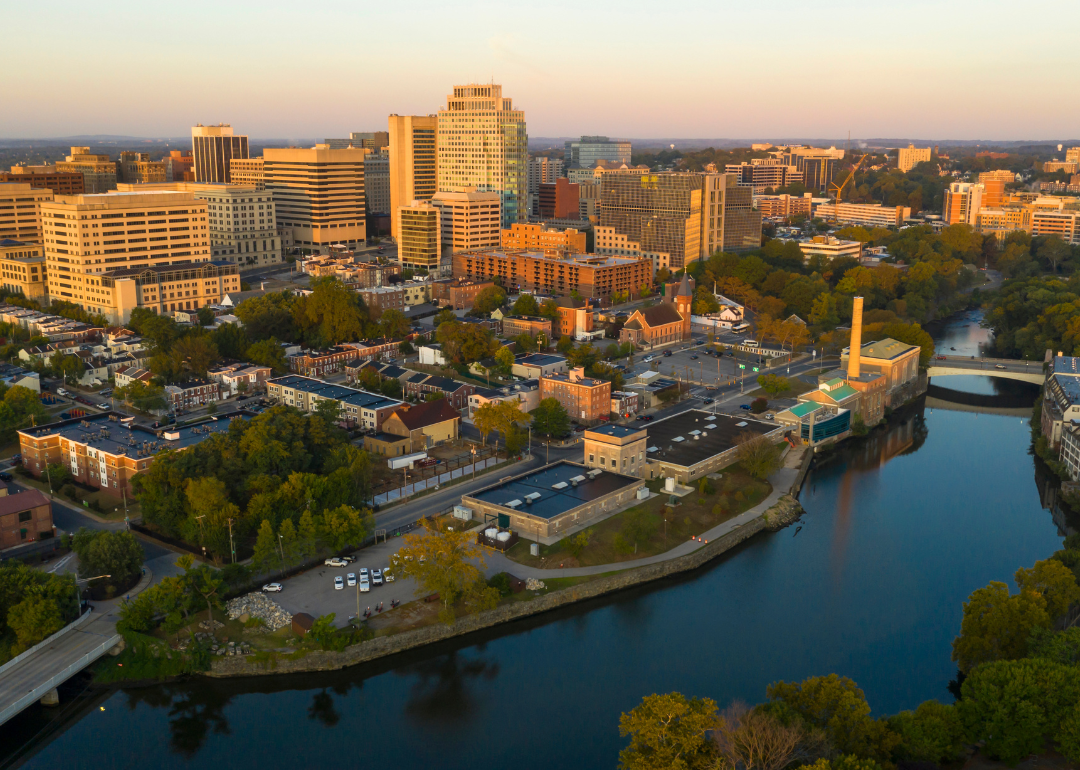
Canva
#42. Delaware
Wilmington as seen during late afternoon.
– Total reported anti-LGBTQ+ hate crimes, 2021: 2
– Percent of police departments reporting data: 100.0% (62 of 62 departments)
– Number of hate crimes per bias motivation
— Anti-Lesbian: 1
— Anti-Gay: 1
— Anti-Bisexual: 0
— Anti-Gender-Nonconforming: 0
— Anti-Transgender: 0
— Anti-Lesbian, Gay, Bisexual, or Transgender (Mixed Group): 0
2021 marked a sharp uptick in hate crimes for Delaware: the DOJ reported a 40% increase from 2020 to 2021. Although the majority of these crimes are antisemitic attacks, the rise of white supremacy and antisemitic ideology is historically connected to attacks against the LGBTQ+ community as well.

Canva
#41. Hawaii
The coastline and luxury hotels and apartments in Honolulu.
– Total reported anti-LGBTQ+ hate crimes, 2021: 3
– Percent of police departments reporting data: 50.0% (2 of 4 departments)
– Number of hate crimes per bias motivation
— Anti-Lesbian: 0
— Anti-Gay: 2
— Anti-Bisexual: 0
— Anti-Gender-Nonconforming: 0
— Anti-Transgender: 0
— Anti-Lesbian, Gay, Bisexual, or Transgender (Mixed Group): 1
In June 2022, Hawaii expanded protections for Hawaii’s LGBTQ+ community. The legislation package included anti-discrimination measures for gender-affirming health care and jury service, as well as a statewide LGBTQ+ commission.
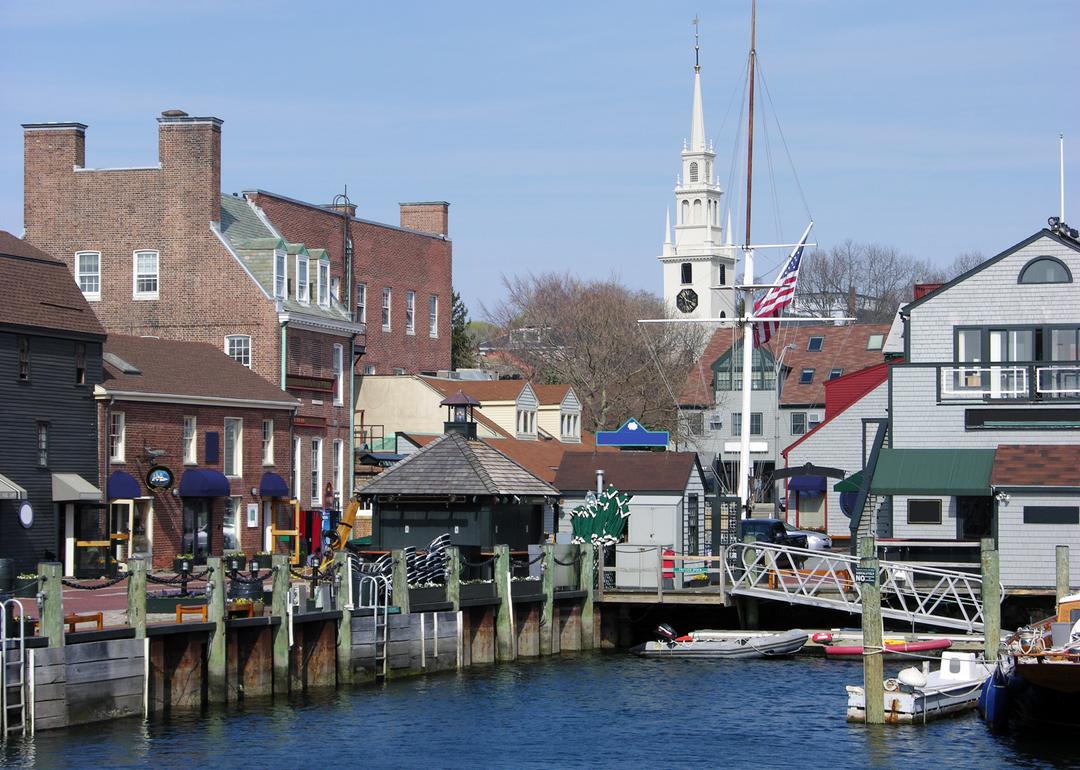
Ramunas Bruzas // Shutterstock
#40. Rhode Island
Building, boats, and docks at old harbor in Newport.
– Total reported anti-LGBTQ+ hate crimes, 2021: 3
– Percent of police departments reporting data: 95.9% (47 of 49 departments)
– Number of hate crimes per bias motivation
— Anti-Lesbian: 0
— Anti-Gay: 2
— Anti-Bisexual: 0
— Anti-Gender-Nonconforming: 0
— Anti-Transgender: 0
— Anti-Lesbian, Gay, Bisexual, or Transgender (Mixed Group): 1
Rhode Island is another state that has seen an increase in extremist activity related to antisemitism, racism, and anti-LGBTQ+ sentiment. The increase in hate crimes and violence has been linked to hate groups such as the Proud Boys, Oath Keepers, Patriot Front, and Nationalist Socialist Club.

Canva
#39. Wyoming
Buildings in Casper as seen at night.
– Total reported anti-LGBTQ+ hate crimes, 2021: 4
– Percent of police departments reporting data: 72.5% (325 of 448 departments)
– Number of hate crimes per bias motivation
— Anti-Lesbian: 2
— Anti-Gay: 0
— Anti-Bisexual: 0
— Anti-Gender-Nonconforming: 0
— Anti-Transgender: 0
— Anti-Lesbian, Gay, Bisexual, or Transgender (Mixed Group): 2
Wyoming is one of the only states left in the country without any criminal hate crime statutes. In 1998, a gay college student named Matthew Shepard was beaten and murdered in Laramie, sparking hate crime legislation in many states and even at the federal level. In the 20-plus years after this incident, Wyoming has attempted and failed to pass similar legislation multiple times.

Marc Cappelletti // Shutterstock
#38. Alaska
Boats and buildings in Sitka.
– Total reported anti-LGBTQ+ hate crimes, 2021: 4
– Percent of police departments reporting data: 76.9% (30 of 39 departments)
– Number of hate crimes per bias motivation
— Anti-Lesbian: 1
— Anti-Gay: 2
— Anti-Bisexual: 0
— Anti-Gender-Nonconforming: 0
— Anti-Transgender: 1
— Anti-Lesbian, Gay, Bisexual, or Transgender (Mixed Group): 0
Experts say Alaska’s consistently low hate crime rate is a product of underreporting, not an absence of discrimination. In 2021, the Anchorage Field Office of the FBI initiated a statewide hate crime awareness and reporting campaign. The goal of the campaign was to spread awareness of what constitutes a hate crime and how to report it.

Canva
#37. West Virginia
An aerial view of downtown Charleston at sunset.
– Total reported anti-LGBTQ+ hate crimes, 2021: 6
– Percent of police departments reporting data: 56.8% (247 of 435 departments)
– Number of hate crimes per bias motivation
— Anti-Lesbian: 0
— Anti-Gay: 3
— Anti-Bisexual: 0
— Anti-Gender-Nonconforming: 1
— Anti-Transgender: 0
— Anti-Lesbian, Gay, Bisexual, or Transgender (Mixed Group): 2
West Virginia is another state that does not include sexual orientation or gender identity under its criminal hate crime statute. This was most recently upheld in a case that reached the West Virginia Supreme Court in 2017. The ruling affected the outcome of a case in the state where a college athlete accosted and assaulted two men after seeing them kiss in public. The ruling allowed the attacker to be tried on lesser misdemeanor charges.
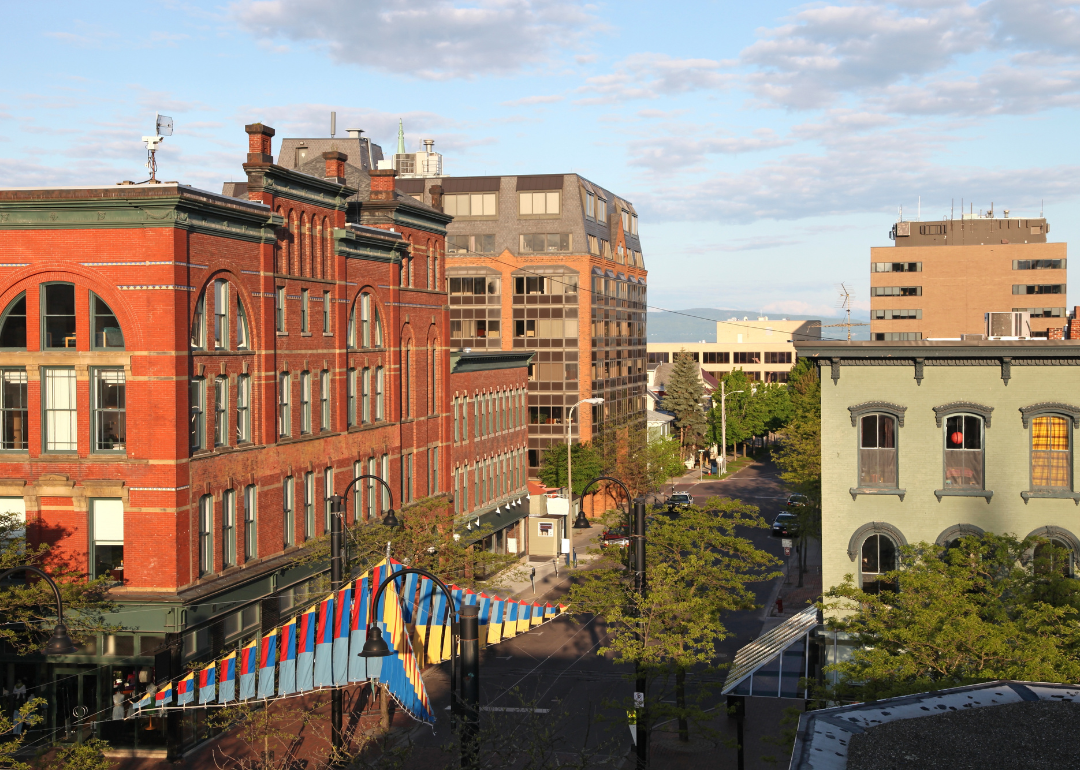
Canva
#36. Vermont
Buildings lining a street in downtown Burlington.
– Total reported anti-LGBTQ+ hate crimes, 2021: 6
– Percent of police departments reporting data: 100.0% (88 of 88 departments)
– Number of hate crimes per bias motivation
— Anti-Lesbian: 0
— Anti-Gay: 4
— Anti-Bisexual: 0
— Anti-Gender-Nonconforming: 0
— Anti-Transgender: 0
— Anti-Lesbian, Gay, Bisexual, or Transgender (Mixed Group): 2
Vermont recently added a provision to hate crime law to more effectively prosecute and win convictions for hate crimes. Previously, the law said the crime needed to be “maliciously motivated,” but the provision amended the language so that the actions needed to be motivated “in whole or in part by a victim’s perceived identity.” Another bill passed in 2021 bans defendants from using a victim’s identity as justification or defense for violence.

Canva
#35. Louisiana
New Orleans near the water at dusk.
– Total reported anti-LGBTQ+ hate crimes, 2021: 7
– Percent of police departments reporting data: 53.8% (136 of 253 departments)
– Number of hate crimes per bias motivation
— Anti-Lesbian: 0
— Anti-Gay: 4
— Anti-Bisexual: 1
— Anti-Gender-Nonconforming: 0
— Anti-Transgender: 0
— Anti-Lesbian, Gay, Bisexual, or Transgender (Mixed Group): 2
Louisiana was the first state in the country to include firefighters and police officers as protected classes under hate crime law in 2016. Although the hate crime statute does not technically include gender identity as a protected factor, some transgender activists claim hate crimes actually do little to protect people and argue that more legislative protections in housing and employment would have a more meaningful impact on this community.
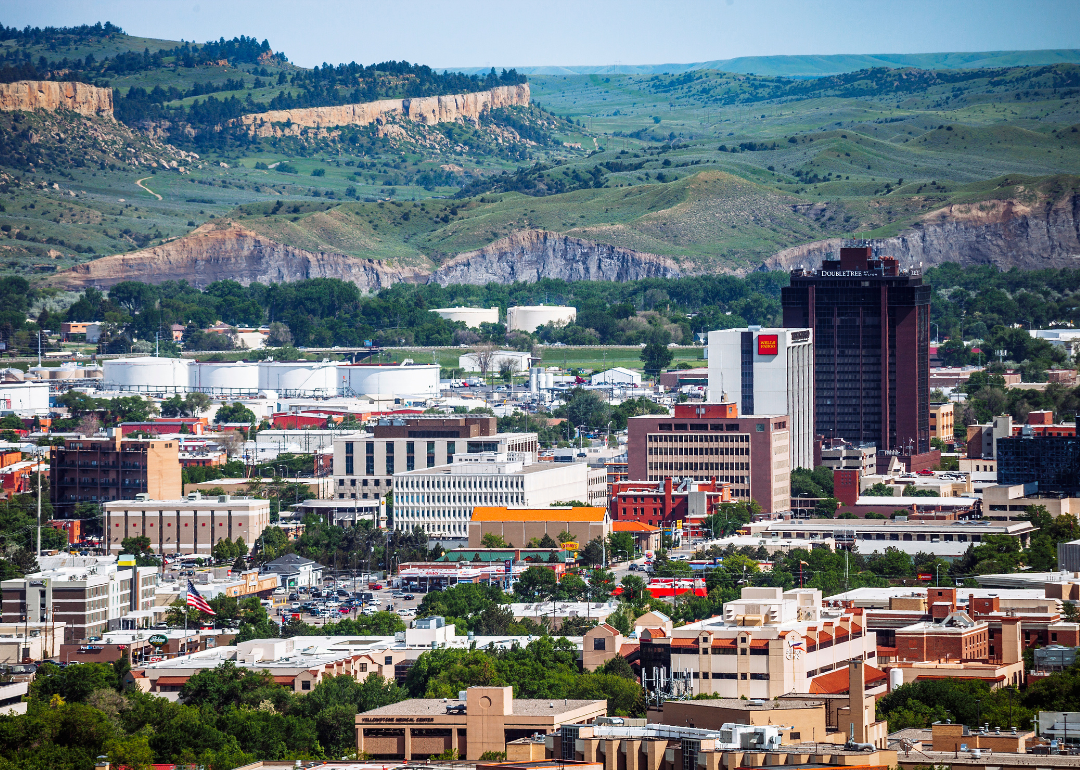
Canva
#34. Montana
Buildings in Billings with scenic hills in the background.
– Total reported anti-LGBTQ+ hate crimes, 2021: 7
– Percent of police departments reporting data: 93.0% (106 of 114 departments)
– Number of hate crimes per bias motivation
— Anti-Lesbian: 0
— Anti-Gay: 3
— Anti-Bisexual: 0
— Anti-Gender-Nonconforming: 0
— Anti-Transgender: 1
— Anti-Lesbian, Gay, Bisexual, or Transgender (Mixed Group): 3
Montana has some of the loosest firearm restrictions, the highest rates of household gun ownership in the country, and gun violence rates well above the national average. This context creates deadly conditions for actions of hate and prejudice. In 2021, a Montana man was tried and convicted for firing an assault rifle into a lesbian woman’s home in a self-described attempt to “rid the town of Basin of its gay and lesbian community.”
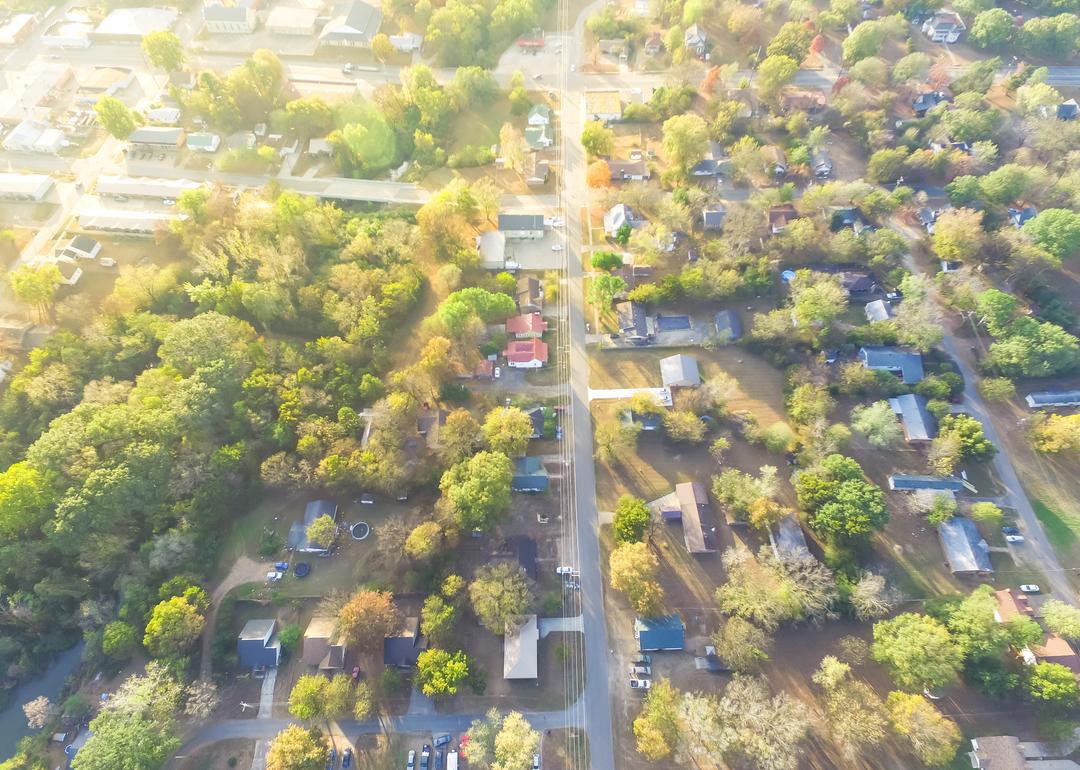
Trong Nguyen // Shutterstock
#33. Arkansas
A scenic suburb in Ozark.
– Total reported anti-LGBTQ+ hate crimes, 2021: 8
– Percent of police departments reporting data: 92.5% (285 of 308 departments)
– Number of hate crimes per bias motivation
— Anti-Lesbian: 1
— Anti-Gay: 2
— Anti-Bisexual: 2
— Anti-Gender-Nonconforming: 2
— Anti-Transgender: 0
— Anti-Lesbian, Gay, Bisexual, or Transgender (Mixed Group): 3
The Arkansas Legislature recently voted to change sentencing for perpetrators of hate crimes in a bill that the Human Rights Watch calls “vague and unenforceable.” The bill was first proposed to increase sentencing if the crime was predicated on the victim’s “race, color, religion, ethnicity, ancestry, national origin, homelessness, gender identity, sexual orientation, sex, disability, or service in United States Armed Forces,” but voted down.
The passed bill allows prosecutors to seek longer prison terms for those who target anyone in a “recognizable and identifiable group,” without any specific enumeration of these groups. The Legislature passed a bill in the same session that allows medical workers to refuse treatment to LGBTQ+ people and in subsequent sessions has voted to impact the public lives of LGBTQ+ people in other ways.
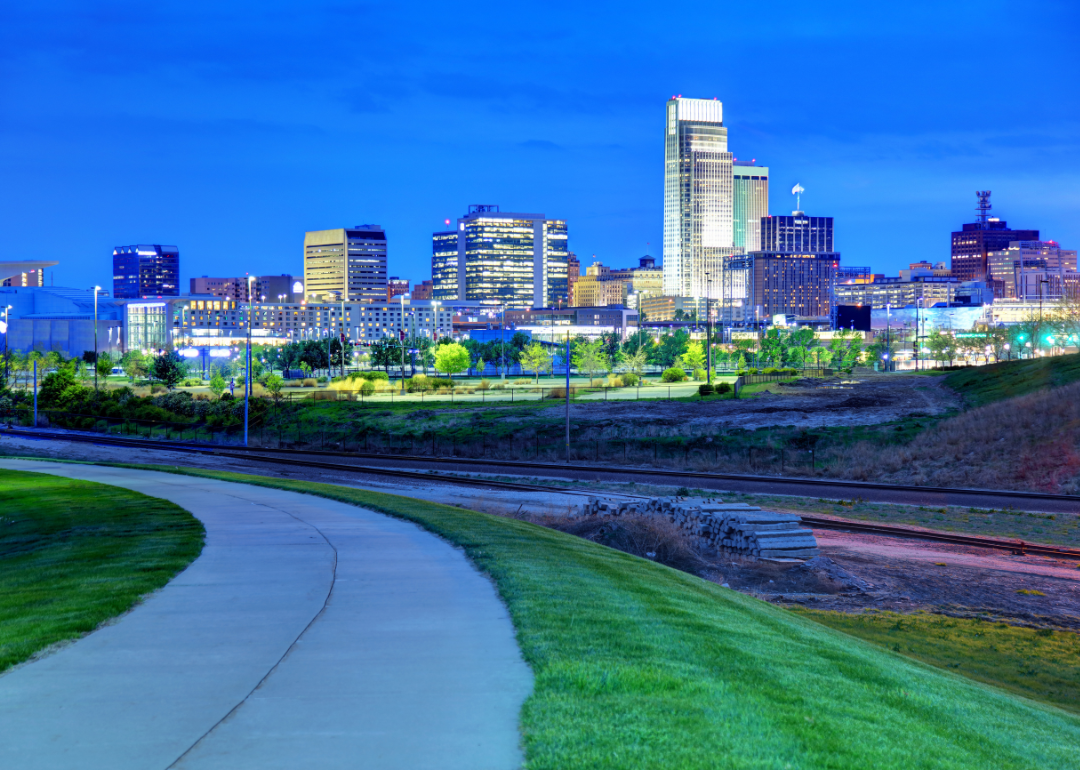
Canva
#32. Nebraska
Train tracks as seen outside Omaha at night.
– Total reported anti-LGBTQ+ hate crimes, 2021: 8
– Percent of police departments reporting data: 94.3% (267 of 283 departments)
– Number of hate crimes per bias motivation
— Anti-Lesbian: 1
— Anti-Gay: 3
— Anti-Bisexual: 0
— Anti-Gender-Nonconforming: 0
— Anti-Transgender: 2
— Anti-Lesbian, Gay, Bisexual, or Transgender (Mixed Group): 2
In May 2023, Nebraska passed a bill banning gender-affirming care for minors in a legislative session that also debated bans on drag performances and restricting bathroom spaces based on biological sex. State Sen. Senator Megan Hunt, one of only two LGBTQ+ legislators in Nebraska, claims the passage of the bill will increase the violence and hate crimes that trans people face.

Canva
#31. New Hampshire
The skyline in downtown Manchester at dusk.
– Total reported anti-LGBTQ+ hate crimes, 2021: 8
– Percent of police departments reporting data: 94.5% (208 of 220 departments)
– Number of hate crimes per bias motivation
— Anti-Lesbian: 0
— Anti-Gay: 3
— Anti-Bisexual: 0
— Anti-Gender-Nonconforming: 0
— Anti-Transgender: 1
— Anti-Lesbian, Gay, Bisexual, or Transgender (Mixed Group): 4
The New Hampshire Attorney General’s office created a civil rights unit in 2017 with the specific task of identifying and investigating hate crimes. The unit has seen an increase in LGBTQ+-related hate crimes. Assistant Attorney General Sean Locke claims the unit’s goal is to increase reporting as a means to give law enforcement the resources to pinpoint the areas that need attention and protection.
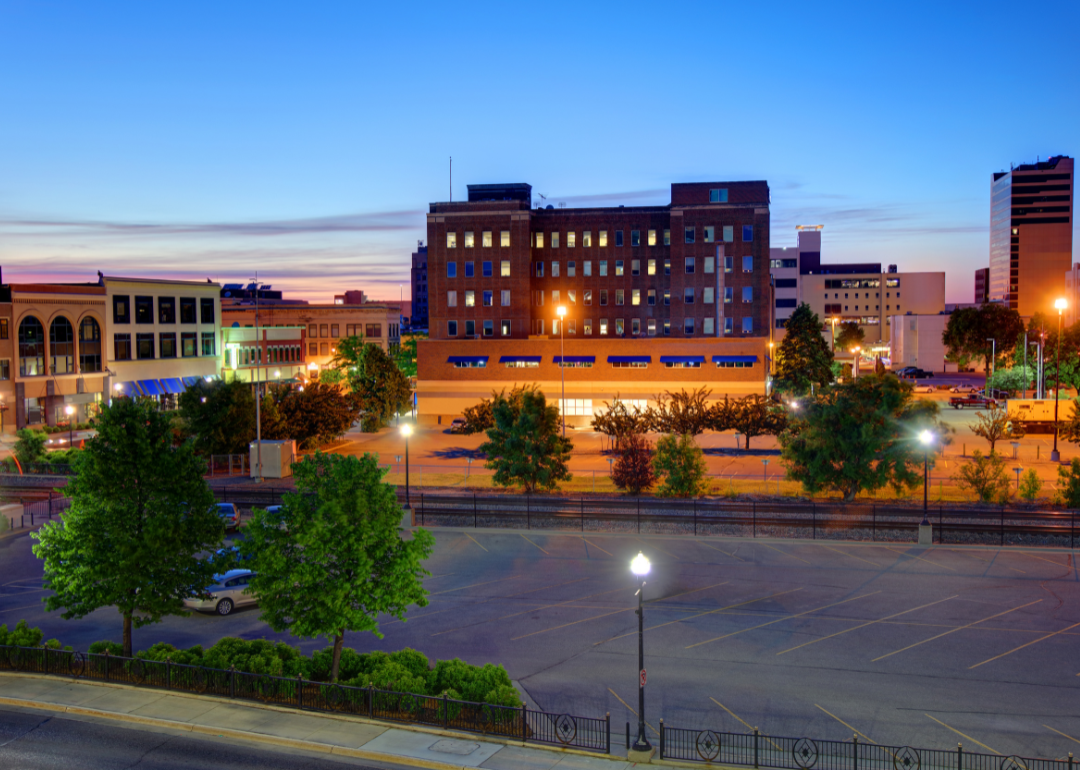
Canva
#30. North Dakota
Buildings in Fargo as seen at night.
– Total reported anti-LGBTQ+ hate crimes, 2021: 8
– Percent of police departments reporting data: 100.0% (112 of 112 departments)
– Number of hate crimes per bias motivation
— Anti-Lesbian: 1
— Anti-Gay: 1
— Anti-Bisexual: 0
— Anti-Gender-Nonconforming: 0
— Anti-Transgender: 0
— Anti-Lesbian, Gay, Bisexual, or Transgender (Mixed Group): 6
North Dakota attempted and failed to pass an updated hate crime statute in February 2023. The testimony from the bill’s hearing claims that North Dakota ranks #51 out of all states plus the District of Columbia for LGBTQ+ protections.

Hank Shiffman // Shutterstock
#29. South Dakota
The western suburbs of Rapid City.
– Total reported anti-LGBTQ+ hate crimes, 2021: 9
– Percent of police departments reporting data: 75.9% (110 of 145 departments)
– Number of hate crimes per bias motivation
— Anti-Lesbian: 2
— Anti-Gay: 2
— Anti-Bisexual: 0
— Anti-Gender-Nonconforming: 0
— Anti-Transgender: 0
— Anti-Lesbian, Gay, Bisexual, or Transgender (Mixed Group): 5
South Dakota follows a similar trend to other Midwestern states with increased legislation restricting gender identity and expression and an uptick in hate crimes. The Anti-Defamation League also reports concern about the gaps in data collection and reporting in many Midwestern states including South Dakota, where 110 agencies reported hate crime data in 2021, down from 128 agencies in 2020.
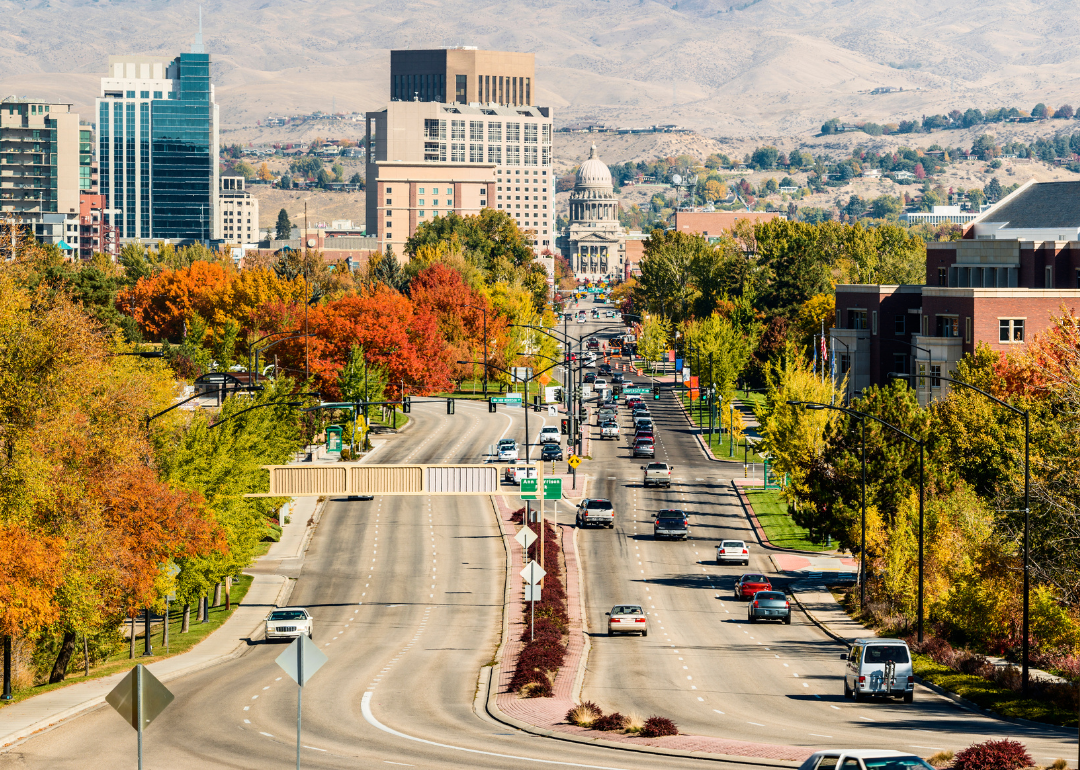
Canva
#28. Idaho
Cars driving down Capitol Boulevard in Boise.
– Total reported anti-LGBTQ+ hate crimes, 2021: 11
– Percent of police departments reporting data: 96.5% (110 of 114 departments)
– Number of hate crimes per bias motivation
— Anti-Lesbian: 2
— Anti-Gay: 4
— Anti-Bisexual: 0
— Anti-Gender-Nonconforming: 0
— Anti-Transgender: 0
— Anti-Lesbian, Gay, Bisexual, or Transgender (Mixed Group): 5
The specifics of Idaho’s hate crime laws make prosecution especially difficult; the law requires the harassment or attack to intentionally target a person. Targeting public places or areas does not meet this qualification. The ambiguity in this definition created a legal loophole for events in 2022 including the posting of antisemitic flyers and swastika stickers posted on the Anne Frank Human Rights Memorial because no individual target was articulated. Advocates for Idaho’s hate crime victims formed an organization called Add the Words, which helps people access mental health and leave unsafe places of employment and harassment.
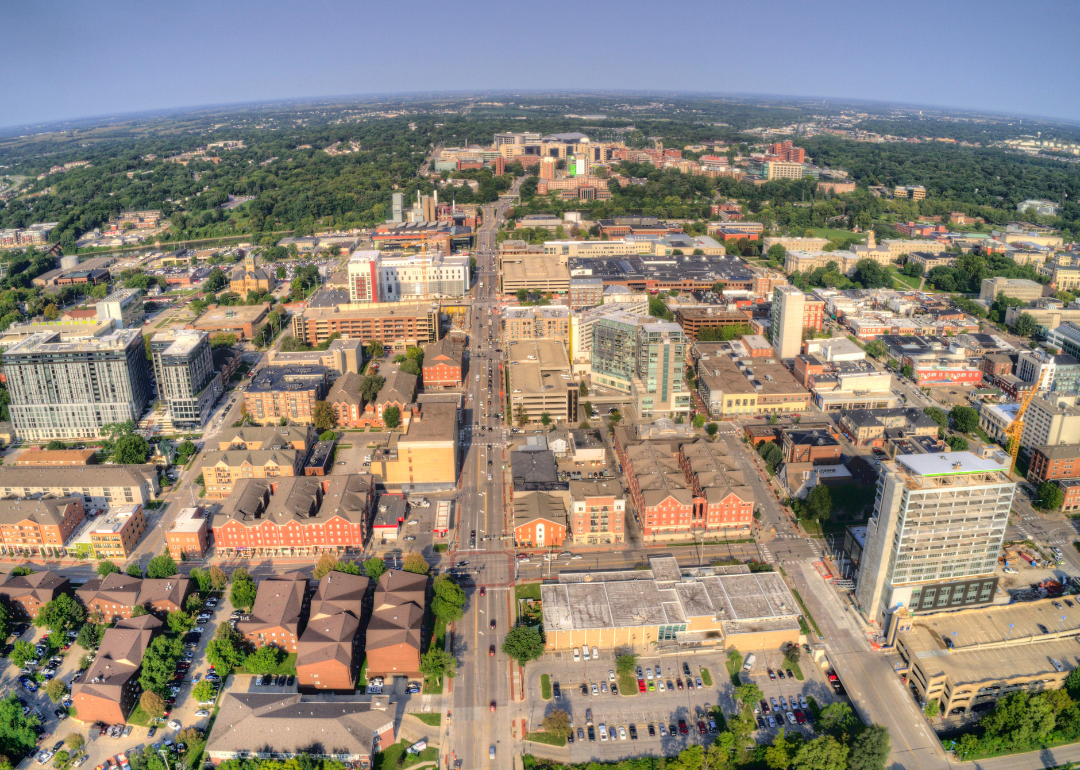
Canva
#27. Iowa
An aerial view of Iowa City on a sunny day.
– Total reported anti-LGBTQ+ hate crimes, 2021: 13
– Percent of police departments reporting data: 75.4% (208 of 276 departments)
– Number of hate crimes per bias motivation
— Anti-Lesbian: 0
— Anti-Gay: 4
— Anti-Bisexual: 0
— Anti-Gender-Nonconforming: 1
— Anti-Transgender: 2
— Anti-Lesbian, Gay, Bisexual, or Transgender (Mixed Group): 6
In 2023, Iowa passed education reform that bans books that contain sexual content, restricts the teaching of LGBTQ+ content, and mandates schools to notify parents if a student requests new pronouns. The reform package was strongly opposed by LGBTQ+ groups, the Iowa State Education Association, and Iowa Safe Schools, who argued the legislation would cause irreparable harm to LGBTQ+ children and mandate discriminatory practices.
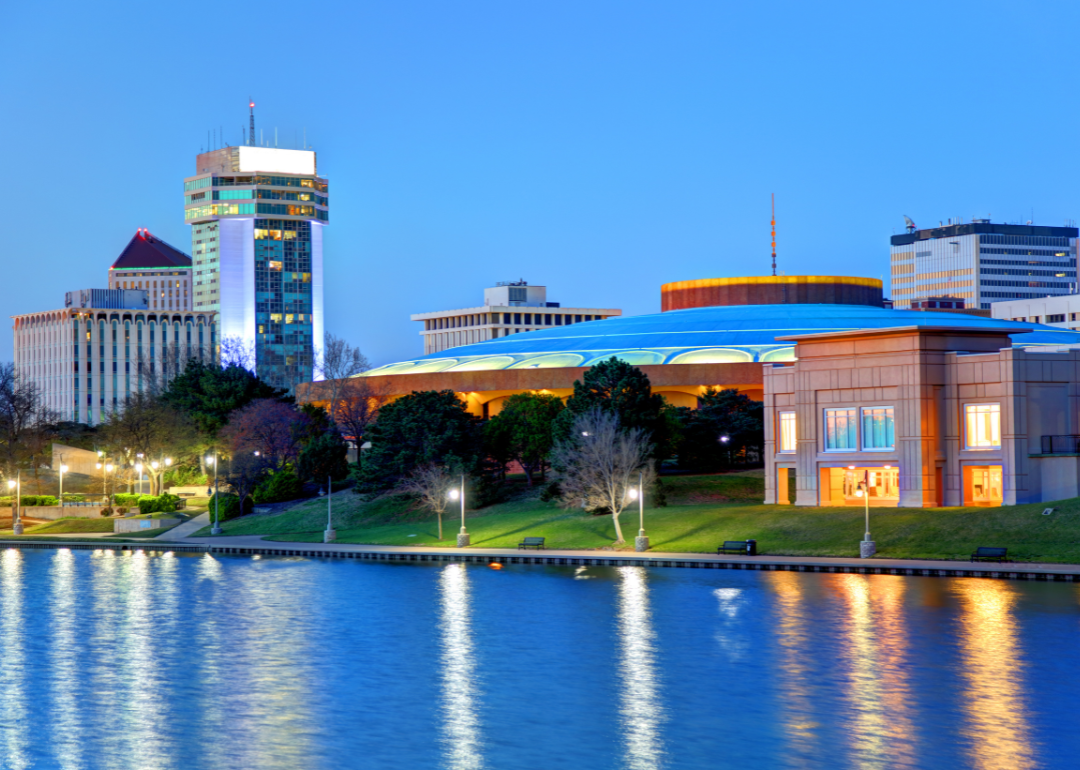
Canva
#26. Kansas
A night view of buildings along a river in Wichita.
– Total reported anti-LGBTQ+ hate crimes, 2021: 15
– Percent of police departments reporting data: 82.5% (334 of 405 departments)
– Number of hate crimes per bias motivation
— Anti-Lesbian: 1
— Anti-Gay: 1
— Anti-Bisexual: 1
— Anti-Gender-Nonconforming: 0
— Anti-Transgender: 1
— Anti-Lesbian, Gay, Bisexual, or Transgender (Mixed Group): 11
Several recent court cases in Kansas have set a clear legal course for the rights of LGBTQ+ youth. In 2022, a judge ruled that a public school policy cannot legally prevent teachers from outing LGBTQ+ youth to parents and guardians, and a Fort Riley teacher won a lawsuit in September 2022 in which she argued calling students by “preferred” names and pronouns violated her religious beliefs. The importance of using preferred pronouns and language around LGBTQ+ youth is affirmed by both LGBTQ+ advocacy groups and medical associations alike, such as the American Psychological Association and American Medical Association.
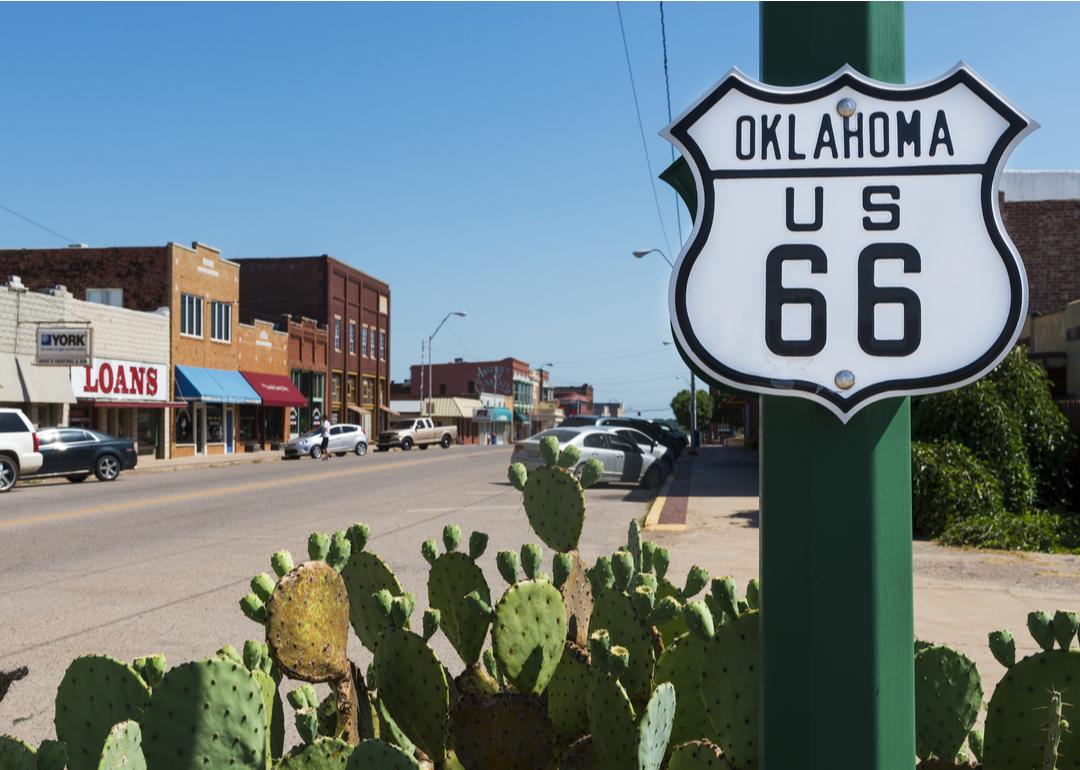
TLF Images // Shutterstock
#25. Oklahoma
Buildings along US Route 66 in Oklahoma.
– Total reported anti-LGBTQ+ hate crimes, 2021: 15
– Percent of police departments reporting data: 99.3% (452 of 455 departments)
– Number of hate crimes per bias motivation
— Anti-Lesbian: 0
— Anti-Gay: 10
— Anti-Bisexual: 2
— Anti-Gender-Nonconforming: 0
— Anti-Transgender: 0
— Anti-Lesbian, Gay, Bisexual, or Transgender (Mixed Group): 3
An attack on a gay man in Oklahoma City in 2020 sparked debate about appropriate consequences and punishment for hate crimes. After the beating of Christian Council, local LGBTQ+ advocacy groups fought for restitution rooted in restorative justice practices, claiming that jail time does not deter hate crimes. Restorative justice is a practice that seeks to address harm by working with the victim and the offender to repair the harm.

Canva
#24. Connecticut
Hartford’s skyline as seen from a distance.
– Total reported anti-LGBTQ+ hate crimes, 2021: 16
– Percent of police departments reporting data: 100.0% (107 of 107 departments)
– Number of hate crimes per bias motivation
— Anti-Lesbian: 4
— Anti-Gay: 3
— Anti-Bisexual: 3
— Anti-Gender-Nonconforming: 0
— Anti-Transgender: 0
— Anti-Lesbian, Gay, Bisexual, or Transgender (Mixed Group): 6
In 2021, Connecticut updated its hate crime laws by expanding the attorney general’s authority to “investigate hate crimes, civil rights violations, initiate legal proceedings, and seek relief for affected persons.” The following year, Connecticut passed a law establishing a hate crimes investigation unit, requiring law enforcement to develop better practices in reporting and investigation. Together, these laws seek to ensure that state resources are being effectively utilized to fight hate crimes in Connecticut.

Brandon Burris // Shutterstock
#23. Arizona
A highway leading into downtown Phoenix.
– Total reported anti-LGBTQ+ hate crimes, 2021: 18
– Percent of police departments reporting data: 64.6% (82 of 127 departments)
– Number of hate crimes per bias motivation
— Anti-Lesbian: 1
— Anti-Gay: 5
— Anti-Bisexual: 1
— Anti-Gender-Nonconforming: 3
— Anti-Transgender: 1
— Anti-Lesbian, Gay, Bisexual, or Transgender (Mixed Group): 7
Increasing levels of antisemitic violence recently prompted Arizona legislators to pass a $5 million grant program to religious or nonprofit communities at risk of hate crimes and violence, although most hate crimes in Arizona are predicated on race or ethnicity. In Arizona, hate crime law, gender, race or other identifying characteristics can be considered an “aggravating circumstance,” but there is no specific statute. Advocates for LGBTQ+ people and other minority groups claim the lack of specificity makes it difficult for law enforcement to take these cases seriously.
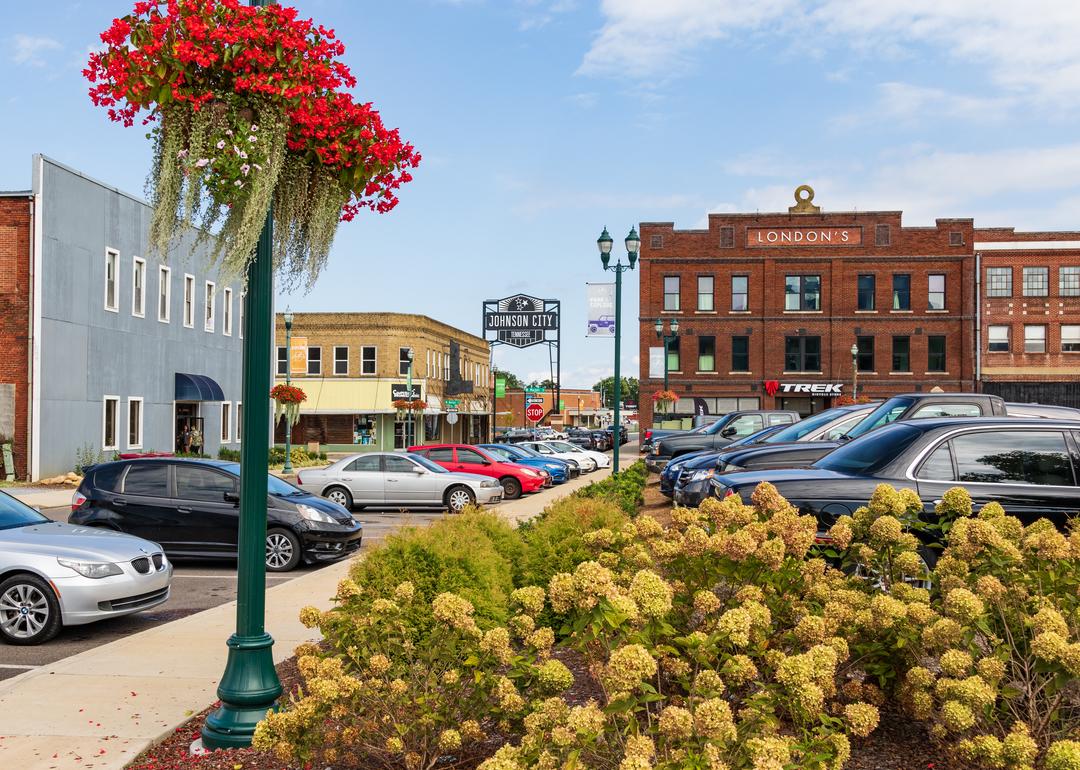
Nolichuckyjake // Shutterstock
#22. Tennessee
Cars parked along the street in Johnson City.
– Total reported anti-LGBTQ+ hate crimes, 2021: 22
– Percent of police departments reporting data: 93.8% (437 of 466 departments)
– Number of hate crimes per bias motivation
— Anti-Lesbian: 2
— Anti-Gay: 3
— Anti-Bisexual: 0
— Anti-Gender-Nonconforming: 2
— Anti-Transgender: 2
— Anti-Lesbian, Gay, Bisexual, or Transgender (Mixed Group): 13
Tennessee hate crimes against the LGBTQ+ community doubled from 2019 to 2021. Activists point to this trend as a direct result of various legislation passed by the Tennessee legislature targeting LGBTQ+ people. Tennessee was the first state to legislate restrictions to drag shows and has since passed 15 laws the Human Rights Campaign reports as a “coordinated push” by anti-LGBTQ groups.

PQK // Shutterstock
#21. South Carolina
The scenic river view and waterfront houses in North Myrtle Beach.
– Total reported anti-LGBTQ+ hate crimes, 2021: 23
– Percent of police departments reporting data: 87.3% (411 of 471 departments)
– Number of hate crimes per bias motivation
— Anti-Lesbian: 1
— Anti-Gay: 14
— Anti-Bisexual: 0
— Anti-Gender-Nonconforming: 0
— Anti-Transgender: 3
— Anti-Lesbian, Gay, Bisexual, or Transgender (Mixed Group): 6
In May 2023, South Carolina Democrats attempted to pass a hate crimes bill allowing harsher punishments for violent crimes against some groups. South Carolina has a deadly history of hate crimes, the most recent and shocking being the murder of nine Black parishioners at the Emanuel African Methodist Episcopal Church in Charleston in 2015. The original bill reform added protections for gender and sexuality but was removed from the final bill because the provision led to a withdrawal of support from Republican lawmakers.
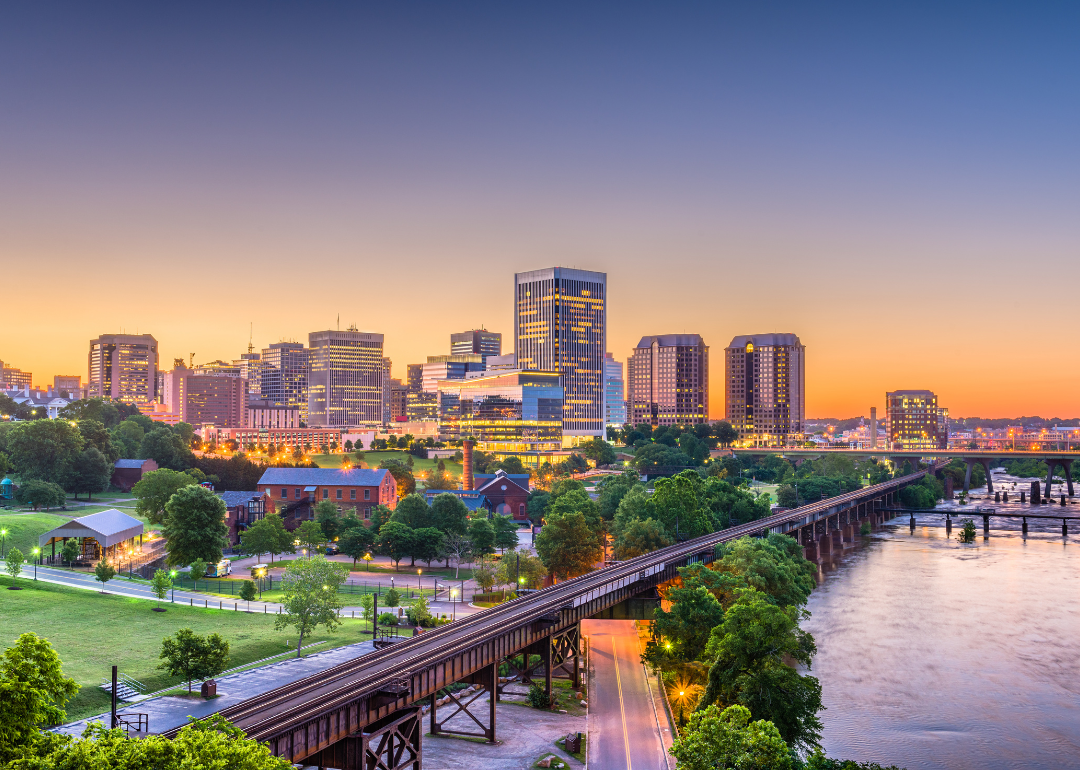
Canva
#20. Virginia
The skyline of Richmond at sunset.
– Total reported anti-LGBTQ+ hate crimes, 2021: 23
– Percent of police departments reporting data: 97.6% (412 of 422 departments)
– Number of hate crimes per bias motivation
— Anti-Lesbian: 2
— Anti-Gay: 11
— Anti-Bisexual: 0
— Anti-Gender-Nonconforming: 1
— Anti-Transgender: 0
— Anti-Lesbian, Gay, Bisexual, or Transgender (Mixed Group): 9
Democrats in the Virginia Legislature are successfully fighting legislation restricting LGBTQ+ rights in schools, bathrooms, and health care institutions, as well as proposing pro-LGBTQ+ legislation, including a bill seeking to remove the Marshall-Newman Amendment from the state constitution. The amendment prohibits marriages for same-gender couples and is invalid under the federal ruling of Obergefell v. Hodges. Nevertheless, LGBTQ+ advocates in Virginia stress the removal of the amendment so it cannot be used to contest the aforementioned ruling at the Supreme Court.

Canva
#19. Indiana
Soybean fields in Indiana at sunset.
– Total reported anti-LGBTQ+ hate crimes, 2021: 26
– Percent of police departments reporting data: 59.3% (198 of 334 departments)
– Number of hate crimes per bias motivation
— Anti-Lesbian: 5
— Anti-Gay: 6
— Anti-Bisexual: 0
— Anti-Gender-Nonconforming: 5
— Anti-Transgender: 6
— Anti-Lesbian, Gay, Bisexual, or Transgender (Mixed Group): 5
Indiana passed an official hate crime statute in 2019, and many Democratic legislators criticized the bill’s lack of enumeration for age, sex, or gender identity. Detractors of the bill continue to push for legislation that gives enforcement power and resources to prosecutors to effectively investigate and prosecute these crimes. The Indiana branch of the NAACP has also pushed for more specific hate crime laws, citing that additional guidance for penalties is needed.
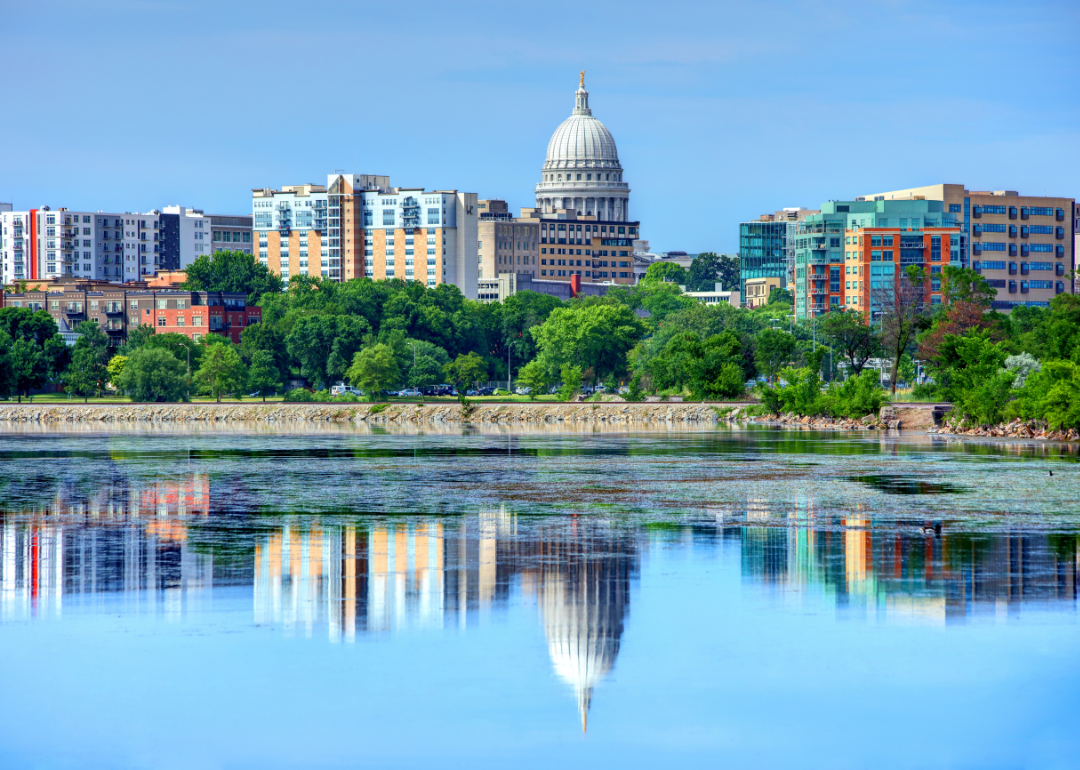
Canva
#18. Wisconsin
Madison as viewed from across the water on a bright, sunny day.
– Total reported anti-LGBTQ+ hate crimes, 2021: 27
– Percent of police departments reporting data: 72.5% (325 of 448 departments)
– Number of hate crimes per bias motivation
— Anti-Lesbian: 1
— Anti-Gay: 6
— Anti-Bisexual: 0
— Anti-Gender-Nonconforming: 6
— Anti-Transgender: 5
— Anti-Lesbian, Gay, Bisexual, or Transgender (Mixed Group): 9
Wisconsin is the home of a landmark Supreme Court case that upheld the constitutionality of hate crime statutes and paved the way for hate crime legislation in the states. The Wisconsin-based advocacy group, We Are Many-United Against Hate, is attempting to build a bipartisan commission that seeks to inform about hate crime research and communicate these findings with the community. The founder of the group, Masood Akhtar, believes all parties need to be represented in a unity caucus to change the political culture that permits hate crimes and violence.
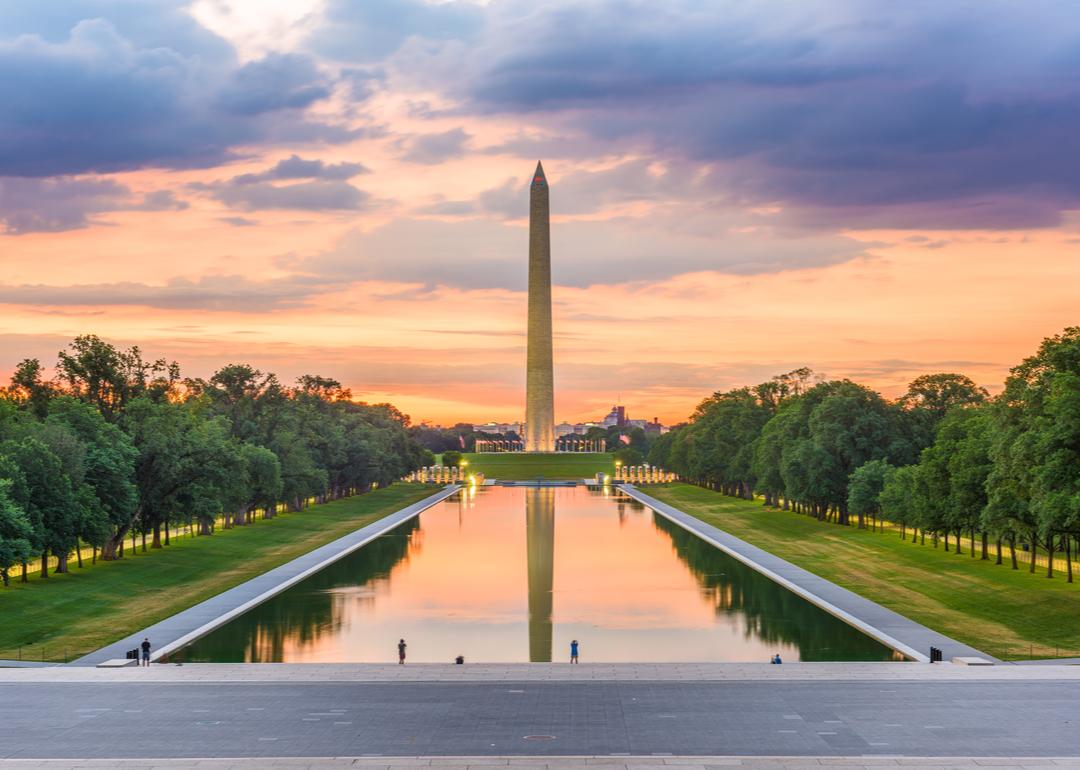
Sean Pavone // Shutterstock
#17. District of Columbia
The Washington Monument and Reflecting Pool.
– Total reported anti-LGBTQ+ hate crimes, 2021: 28
– Percent of police departments reporting data: 66.7% (2 of 3 departments)
– Number of hate crimes per bias motivation
— Anti-Lesbian: 0
— Anti-Gay: 16
— Anti-Bisexual: 1
— Anti-Gender-Nonconforming: 2
— Anti-Transgender: 10
— Anti-Lesbian, Gay, Bisexual, or Transgender (Mixed Group): 0
LGBTQ+ activists in Washington D.C. are expressing concern over the alleged targeting of LGBTQ+ youth in numerous armed robberies and carjackings by juveniles. The data is difficult to track and connect because the perpetrators are juveniles and thus entitled to anonymity protections. Mayor Muriel Bowser has long been a strong advocate for the LGBTQ+ community and dubbed the circumstances a juvenile crime emergency.
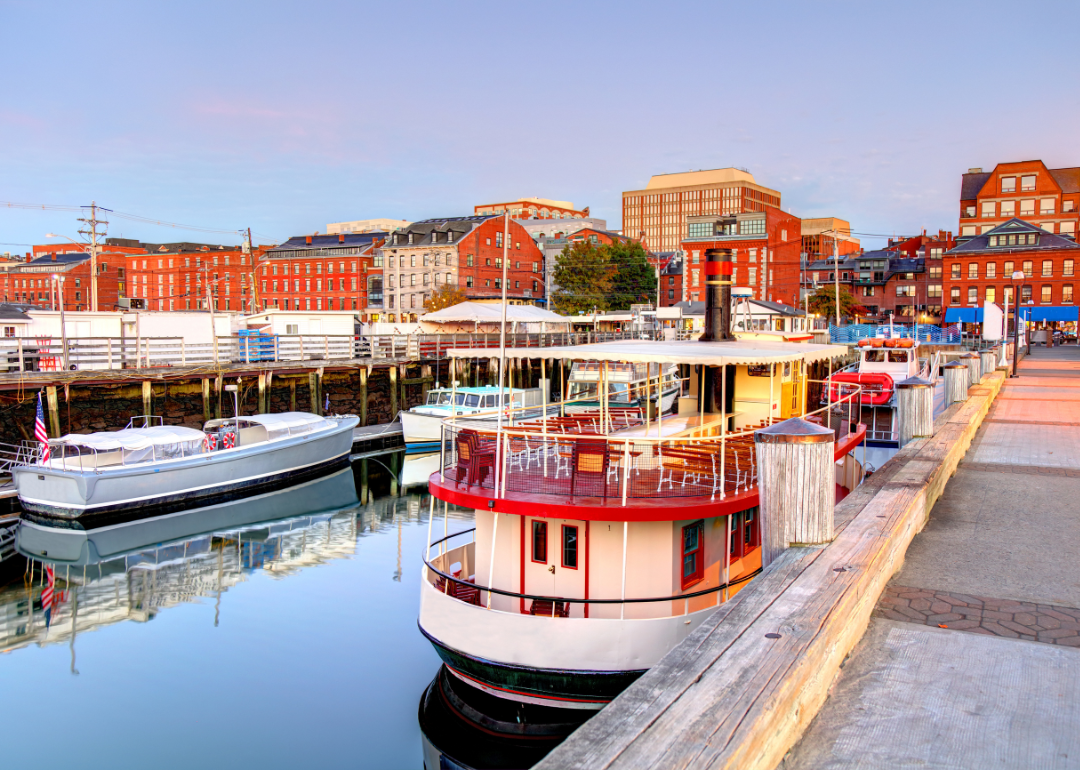
Canva
#16. Maine
The waterfront with ferry’s docked in Portland.
– Total reported anti-LGBTQ+ hate crimes, 2021: 28
– Percent of police departments reporting data: 97.7% (129 of 132 departments)
– Number of hate crimes per bias motivation
— Anti-Lesbian: 1
— Anti-Gay: 7
— Anti-Bisexual: 0
— Anti-Gender-Nonconforming: 1
— Anti-Transgender: 2
— Anti-Lesbian, Gay, Bisexual, or Transgender (Mixed Group): 17
In Maine, hate crimes targeting LGBTQ+ residents increased at a rate that outpaced even the national increase. Darcie McElwee, Maine’s U.S. attorney, is pursuing a plan for the state that includes more outreach and education of law enforcement to understand the population affected.
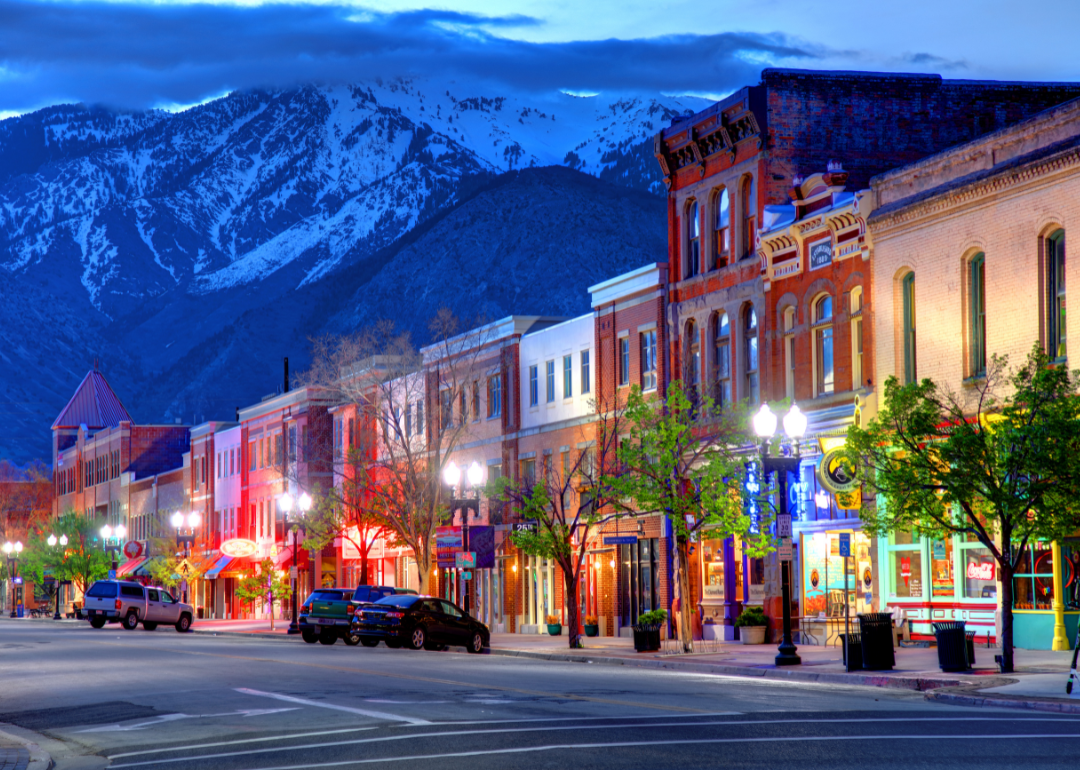
Canva
#15. Utah
Downtown Ogden as seen at night.
– Total reported anti-LGBTQ+ hate crimes, 2021: 34
– Percent of police departments reporting data: 85.7% (126 of 147 departments)
– Number of hate crimes per bias motivation
— Anti-Lesbian: 6
— Anti-Gay: 6
— Anti-Bisexual: 1
— Anti-Gender-Nonconforming: 4
— Anti-Transgender: 5
— Anti-Lesbian, Gay, Bisexual, or Transgender (Mixed Group): 12
LGBTQ+ people are a top target for hate crimes in Utah, and crimes consistently spike each year in June, when the community celebrates Pride. In 2021, three individuals were assaulted during a Pride event by an attacker using homophobic slurs; other violent incidents included threats and theft of Pride flags.
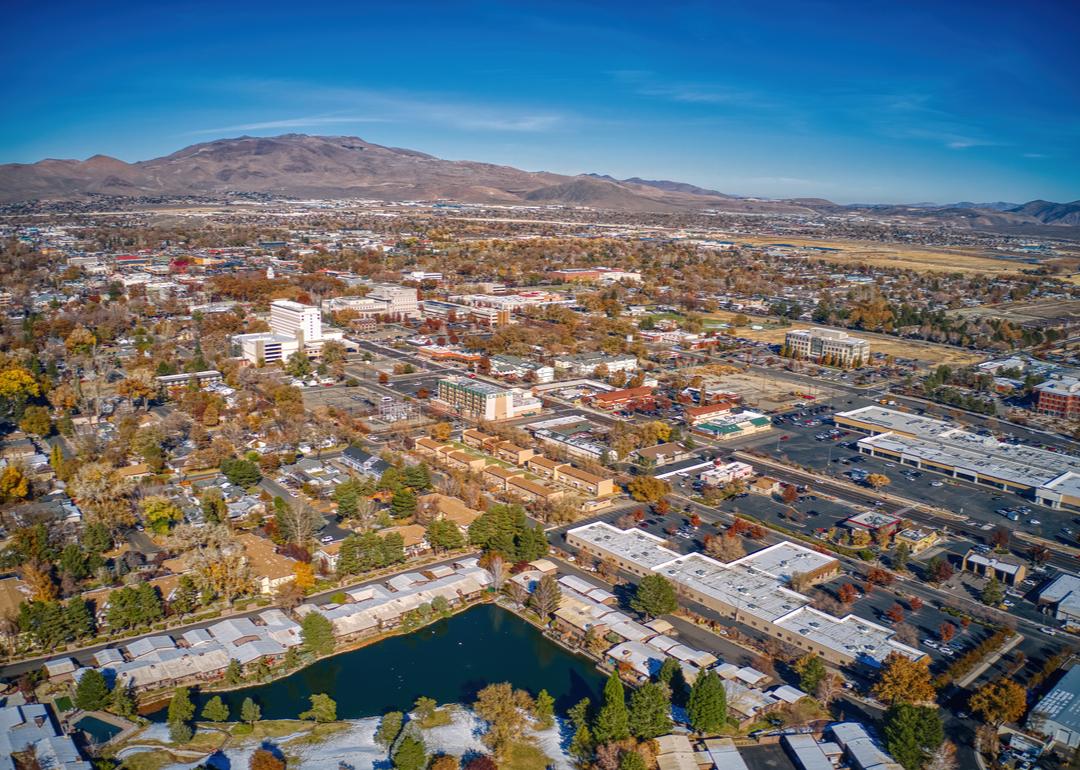
Jacob Boomsma // Shutterstock
#14. Nevada
An aerial View of Carson City.
– Total reported anti-LGBTQ+ hate crimes, 2021: 35
– Percent of police departments reporting data: 80.0% (56 of 70 departments)
– Number of hate crimes per bias motivation
— Anti-Lesbian: 4
— Anti-Gay: 13
— Anti-Bisexual: 1
— Anti-Gender-Nonconforming: 1
— Anti-Transgender: 4
— Anti-Lesbian, Gay, Bisexual, or Transgender (Mixed Group): 12
In 2023, Nevada Gov. Joe Lombardo vetoed a bill barring people convicted of hate crimes from owning guns. At the same time, Nevada legislators are attempting to bolster civil rights for LGBTQ+ Nevadans by creating an LGBTQ+ Caucus. The two bills the Caucus is reintroducing include one requiring correctional facilities to accommodate adequate housing and security for transgender inmates and another ensuring insurance companies cover gender-affirming care.
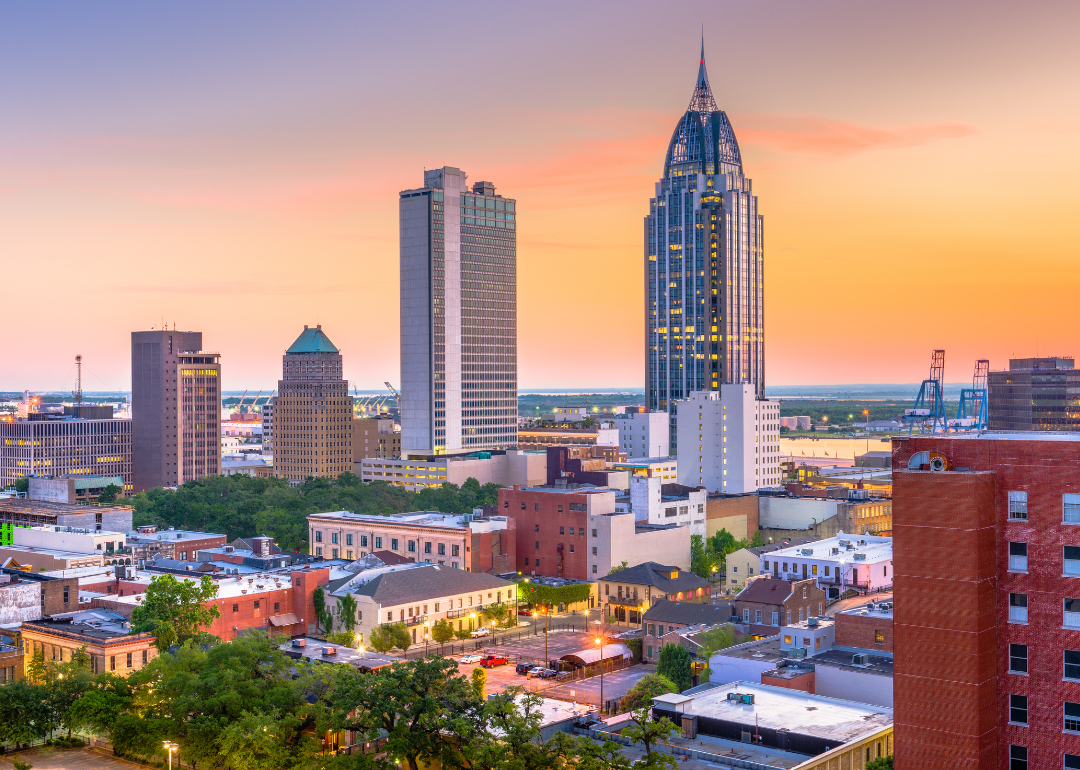
Canva
#13. Alabama
The Mobile skyline as seen at dusk.
– Total reported anti-LGBTQ+ hate crimes, 2021: 36
– Percent of police departments reporting data: 81.7% (356 of 436 departments)
– Number of hate crimes per bias motivation
— Anti-Lesbian: 0
— Anti-Gay: 18
— Anti-Bisexual: 2
— Anti-Gender-Nonconforming: 4
— Anti-Transgender: 0
— Anti-Lesbian, Gay, Bisexual, or Transgender (Mixed Group): 12
Although Alabama passed state legislation in 2022 restricting issues of gender identity in schools and criminalizing gender-affirming care, activists in the state have accomplished LGBTQ+-inclusive, nondiscrimination legislation in the localities of Birmingham and the University of Montevallo. Activists hold the Vigil for Victims of Hate and Violence of Alabama every year at the state Capitol. The vigil is held in Montgomery on the anniversary of the beating and murder of Billy Jack Gaither in 1999. In 2023, the vigil held a moment of silence for Dana Martin, a Black transgender woman who was found shot in her car in 2019.

Canva
#12. North Carolina
An aerial view of Charlotte on a sunny day.
– Total reported anti-LGBTQ+ hate crimes, 2021: 38
– Percent of police departments reporting data: 72.9% (387 of 531 departments)
– Number of hate crimes per bias motivation
— Anti-Lesbian: 5
— Anti-Gay: 9
— Anti-Bisexual: 1
— Anti-Gender-Nonconforming: 2
— Anti-Transgender: 1
— Anti-Lesbian, Gay, Bisexual, or Transgender (Mixed Group): 20
North Carolina is currently advancing a bill that would limit instruction about sexuality and gender identity in K-4 classes, changing the nature of schools and belonging for LGBTQ+ youth. In a report of the 2021 Southern LGBTQ Experiences Survey, North Carolina teens reported experiences of violence and discrimination: Seventy-six percent of LGBTQ+ respondents in the state reported emotional violence related to their identity, and 21% reported physical violence. The top places where the state’s LGBTQ+ youth reported the most violence were their communities and schools, respectively.

Canva
#11. Kentucky
Downtown Louisville as seen at night.
– Total reported anti-LGBTQ+ hate crimes, 2021: 41
– Percent of police departments reporting data: 91.2% (426 of 467 departments)
– Number of hate crimes per bias motivation
— Anti-Lesbian: 3
— Anti-Gay: 7
— Anti-Bisexual: 6
— Anti-Gender-Nonconforming: 6
— Anti-Transgender: 7
— Anti-Lesbian, Gay, Bisexual, or Transgender (Mixed Group): 23
A bill that would not only ban gender-affirming care for trans minors but force doctors to detransition any youth in their care spurred a massive protest in Kentucky in March 2023. Opponents argued the bill would increase the risk of suicide for trans youth. Advocacy groups are working in local areas to fight the effects of the bill. A group in Lexington presented a petition to the County Council in March 2023 suggesting new ways to protect the gay community from the impact of statewide legislation.

Paul Brady Photography // Shutterstock
#10. Missouri
The St. Louis Gateway Arch in Missouri.
– Total reported anti-LGBTQ+ hate crimes, 2021: 44
– Percent of police departments reporting data: 81.4% (481 of 591 departments)
– Number of hate crimes per bias motivation
— Anti-Lesbian: 5
— Anti-Gay: 17
— Anti-Bisexual: 3
— Anti-Gender-Nonconforming: 3
— Anti-Transgender: 6
— Anti-Lesbian, Gay, Bisexual, or Transgender (Mixed Group): 11
Missouri reported its highest-ever number of hate crimes in 2021; Kansas City reported the largest number of any jurisdiction, at 39. The FBI categorized racial bias as the leading cause, and gender and sexuality as the second most prevalent. The six incidents of anti-trans hate crimes are the highest number ever reported in Missouri. In 2023, Missouri passed legislation banning gender-affirming care for minors, and the American Civil Liberties Union of Missouri stated: “The Jefferson City politicians’ intentional choice to abuse transgender Missourians will devastate trans people and their families.”

ESB Professional // Shutterstock
#9. Georgia
A view of Atlanta’s skyline from Lake Meer in Piedmont Park.
– Total reported anti-LGBTQ+ hate crimes, 2021: 45
– Percent of police departments reporting data: 67.9% (448 of 660 departments)
– Number of hate crimes per bias motivation
— Anti-Lesbian: 5
— Anti-Gay: 23
— Anti-Bisexual: 0
— Anti-Gender-Nonconforming: 4
— Anti-Transgender: 7
— Anti-Lesbian, Gay, Bisexual, or Transgender (Mixed Group): 6
Georgia updated its hate crime law in 2020, imposing additional sentencing guidelines for crimes based on discrimination and hate. The law was passed following the national outrage over the unprovoked murder of Ahmaud Arbery by a former police officer and his son in May 2020. Three years after its passage, LGBTQ+ advocates critiqued that the bill is nothing but a gesture without proper utilization, pointing to rising rates of LGBTQ+ violence and, more specifically, the murder of transgender woman Keshia Chanel Geter.

Canva
#8. Minnesota
The downtown Minneapolis skyline as seen at night.
– Total reported anti-LGBTQ+ hate crimes, 2021: 47
– Percent of police departments reporting data: 97.9% (412 of 421 departments)
– Number of hate crimes per bias motivation
— Anti-Lesbian: 3
— Anti-Gay: 25
— Anti-Bisexual: 0
— Anti-Gender-Nonconforming: 1
— Anti-Transgender: 6
— Anti-Lesbian, Gay, Bisexual, or Transgender (Mixed Group): 14
In 2023, Minnesota passed a sweeping piece of public safety legislation that repealed a null anti-sodomy law and reformed anti-discrimination policies to enhance protections for LGBTQ+ people in housing discrimination and hate crimes. The bill included a provision that mandates that the Minnesota Department of Human Rights collect information on racially motivated incidents and create a database. The bill does not mandate this data collection for incidents motivated by bias predicated on sexual orientation or gender identity.

Canva
#7. Oregon
Portland at sunset with a mountain in the background.
– Total reported anti-LGBTQ+ hate crimes, 2021: 60
– Percent of police departments reporting data: 88.5% (208 of 235 departments)
– Number of hate crimes per bias motivation
— Anti-Lesbian: 2
— Anti-Gay: 32
— Anti-Bisexual: 1
— Anti-Gender-Nonconforming: 2
— Anti-Transgender: 9
— Anti-Lesbian, Gay, Bisexual, or Transgender (Mixed Group): 14
Oregon proposed in 2023 a bill that would allow victims of hate crimes to be released from leases without penalty in order to move away from their harassers and attackers. The legislation is notably different from hate crime legislation focusing on sentencing and fines because this bill centers on the psychological distress of victims.
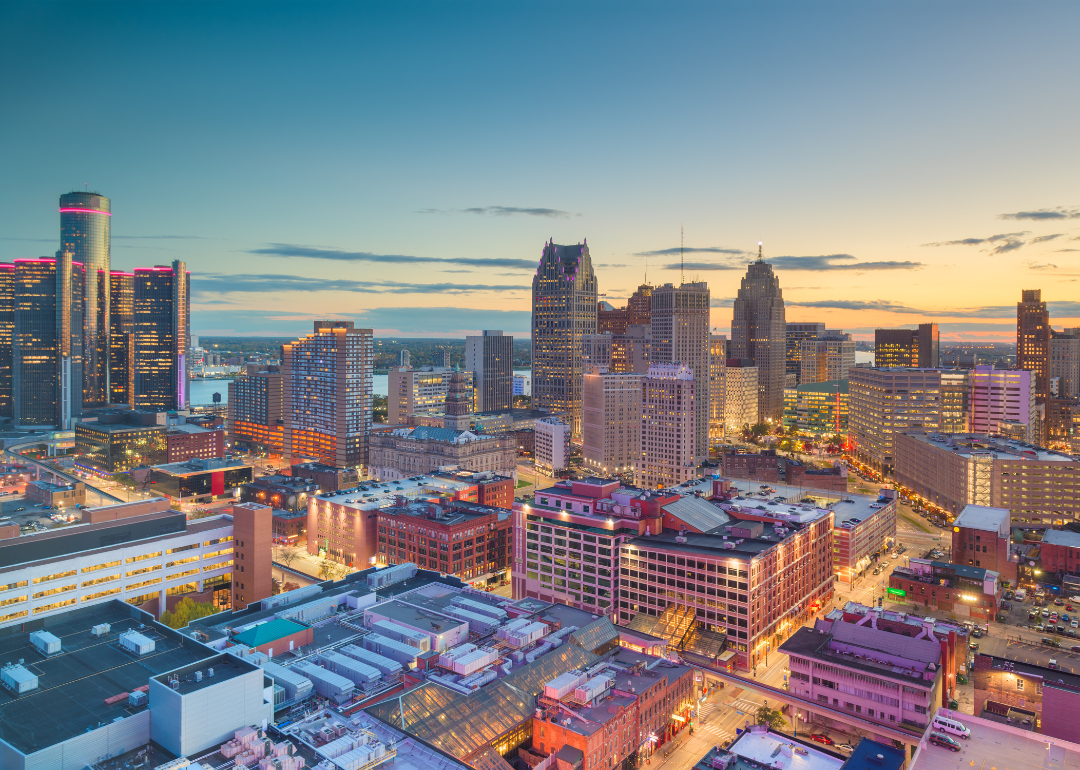
Canva
#6. Michigan
An aerial view of downtown Deroit at dusk.
– Total reported anti-LGBTQ+ hate crimes, 2021: 68
– Percent of police departments reporting data: 94.6% (618 of 653 departments)
– Number of hate crimes per bias motivation
— Anti-Lesbian: 9
— Anti-Gay: 44
— Anti-Bisexual: 4
— Anti-Gender-Nonconforming: 4
— Anti-Transgender: 7
— Anti-Lesbian, Gay, Bisexual, or Transgender (Mixed Group): 0
Michigan expanded its anti-discrimination laws in March 2023 to include protections for LGBTQ+ people. Democrats in the state legislature are hoping to add LGBTQ+ protections to the hate crime law as a next step of reform: Democrats seek to update the definition of a hate crime and establish an act that would penalize the vandalism of churches, synagogues, and other cultural or communal centers as acts of hate.

Canva
#5. Colorado
An aerial view of downtown Denver on a sunny day.
– Total reported anti-LGBTQ+ hate crimes, 2021: 76
– Percent of police departments reporting data: 95.1% (235 of 247 departments)
– Number of hate crimes per bias motivation
— Anti-Lesbian: 7
— Anti-Gay: 22
— Anti-Bisexual: 1
— Anti-Gender-Nonconforming: 4
— Anti-Transgender: 13
— Anti-Lesbian, Gay, Bisexual, or Transgender (Mixed Group): 31
Colorado was home to one of the nation’s most shocking hate crimes in November 2022. In Colorado Springs, a shooter entered a gay nightclub and opened fire, killing five people and wounding 17 more. A 2022 Colorado survey found that 1 in 3 adults in Colorado reported experiencing a bias-motivated incident or hate crime, and 1 in 5 experienced a hate crime or bias-motivated incident based on sexual orientation.
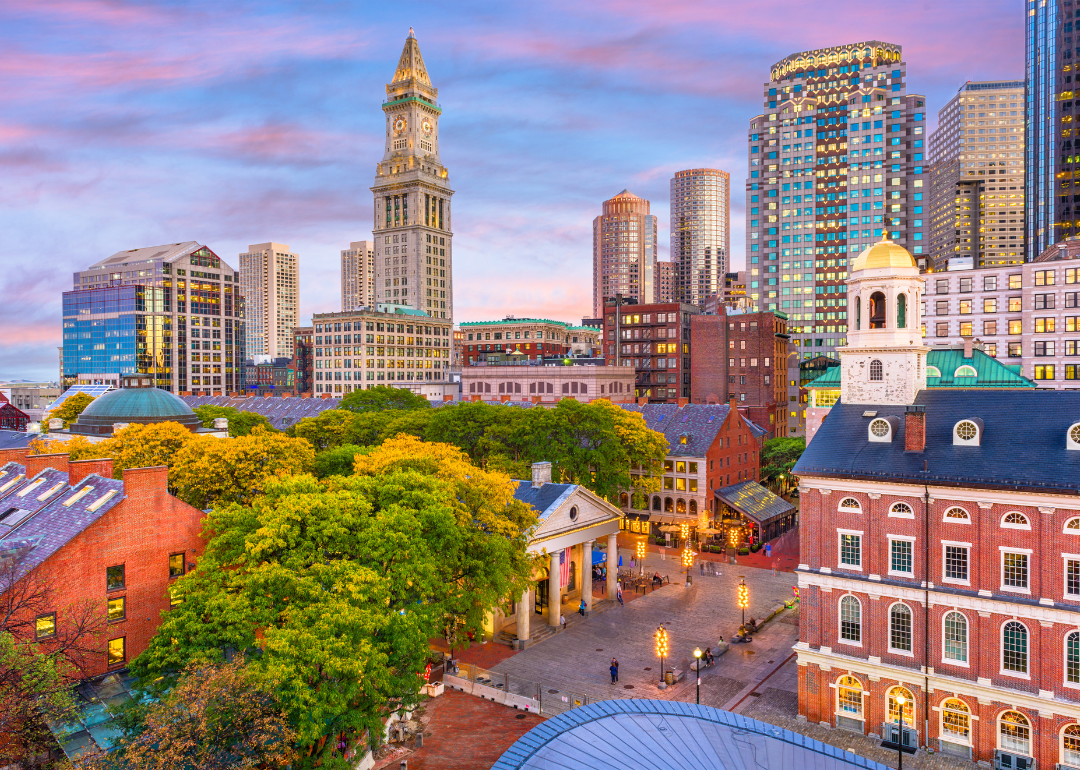
Canva
#4. Massachusetts
An aerial view of downtown Boston at dusk.
– Total reported anti-LGBTQ+ hate crimes, 2021: 84
– Percent of police departments reporting data: 91.0% (376 of 413 departments)
– Number of hate crimes per bias motivation
— Anti-Lesbian: 16
— Anti-Gay: 50
— Anti-Bisexual: 2
— Anti-Gender-Nonconforming: 3
— Anti-Transgender: 5
— Anti-Lesbian, Gay, Bisexual, or Transgender (Mixed Group): 14
Churches and hospitals were top targets for LGBTQ+ hate crimes in Massachusetts in 2022. Boston Children’s Hospital received threats of violence over a wing offering surgical care to trans youth, which eventually escalated to bomb threats. Additionally, a trans flag was burned at the United Parish in Brookline, a church known to be welcoming to members of the LGBTQ+ community.
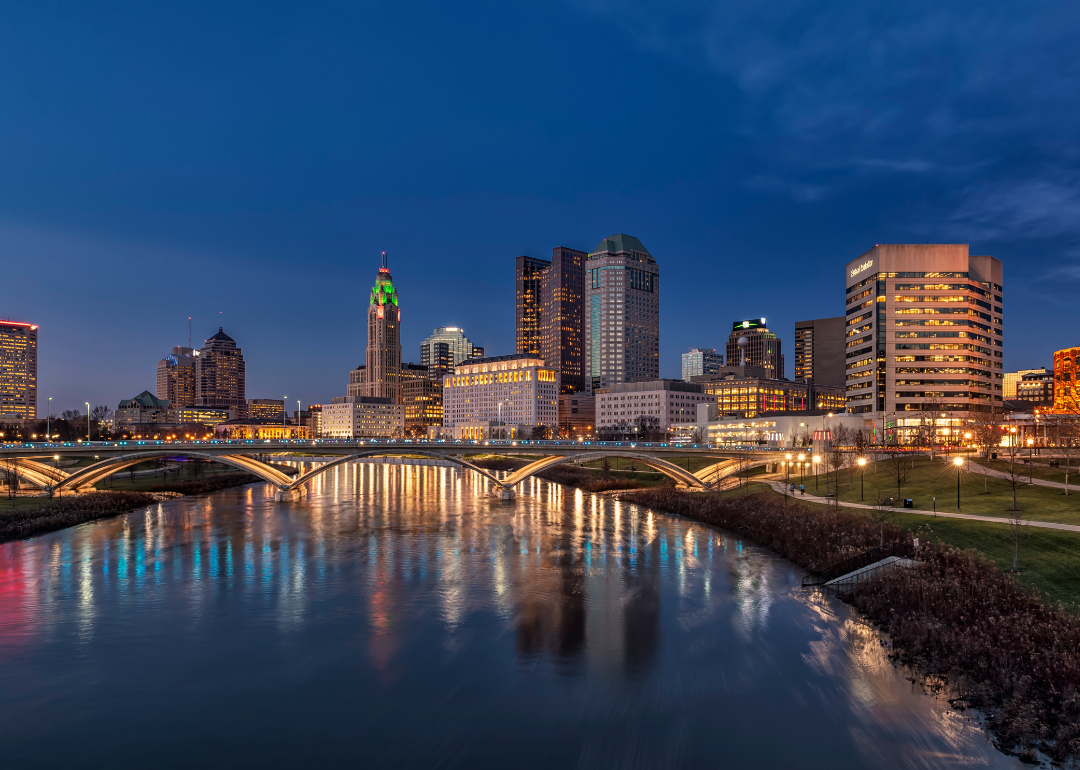
Canva
#3. Ohio
The river leading into Columbus at night.
– Total reported anti-LGBTQ+ hate crimes, 2021: 99
– Percent of police departments reporting data: 69.3% (597 of 862 departments)
– Number of hate crimes per bias motivation
— Anti-Lesbian: 8
— Anti-Gay: 24
— Anti-Bisexual: 3
— Anti-Gender-Nonconforming: 12
— Anti-Transgender: 28
— Anti-Lesbian, Gay, Bisexual, or Transgender (Mixed Group): 24
The Human Rights Council has reported 10 killings of transgender women in Cleveland from 2013 to the present. Although Ohio allows the changing of gender markers on IDs and lacks some of the LGBTQ+ criminalization in other states, the state still lacks hate crime protections for LGBTQ+ individuals. People of that community in the state also have high poverty and unemployment rates and lower access to health care.

Canva
#2. Washington
An aerial view of Seattle with the Space Needle in the foreground.
– Total reported anti-LGBTQ+ hate crimes, 2021: 115
– Percent of police departments reporting data: 90.9% (249 of 274 departments)
– Number of hate crimes per bias motivation
— Anti-Lesbian: 9
— Anti-Gay: 59
— Anti-Bisexual: 1
— Anti-Gender-Nonconforming: 8
— Anti-Transgender: 11
— Anti-Lesbian, Gay, Bisexual, or Transgender (Mixed Group): 27
In 2023, Washington joined Massachusetts, California, New Mexico, Illinois, and D.C. on a list of states passing shield laws to protect medical providers and trans people seeking gender-affirming care in the state. Additionally, Washington passed a law in the spring of 2023 protecting minors seeking gender-affirming care from parental intervention.

Roschetzky Photography // Shutterstock
#1. Texas
An aerial view of Austin and Lady Bird Lake.
– Total reported anti-LGBTQ+ hate crimes, 2021: 132
– Percent of police departments reporting data: 84.5% (1,012 of 1,197 departments)
– Number of hate crimes per bias motivation
— Anti-Lesbian: 17
— Anti-Gay: 48
— Anti-Bisexual: 0
— Anti-Gender-Nonconforming: 11
— Anti-Transgender: 16
— Anti-Lesbian, Gay, Bisexual, or Transgender (Mixed Group): 40
At least 1.8 million Texans identify as LGBTQ+, the second-highest population in any U.S. state. In 2023, in Texas, the Legislature banned gender-affirming care for trans minors, placed restrictions on college sports teams on the basis of biological sex, and placed restrictions on drag shows, but restrictions on content taught in school failed to pass. Additionally, Texas still does not have anti-discrimination laws for gender identity and sexual orientation, even though a 2021 survey found roughly 3 in 4 Texans support such protections.
Data reporting by Emilia Ruzicka. Story editing by Esprit Smith. Copy editing by Paris Close. Photo selection by Abigail Renaud.
